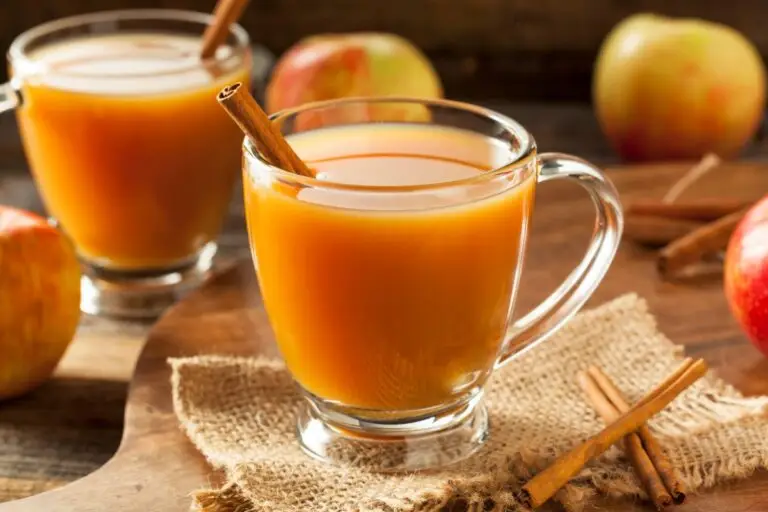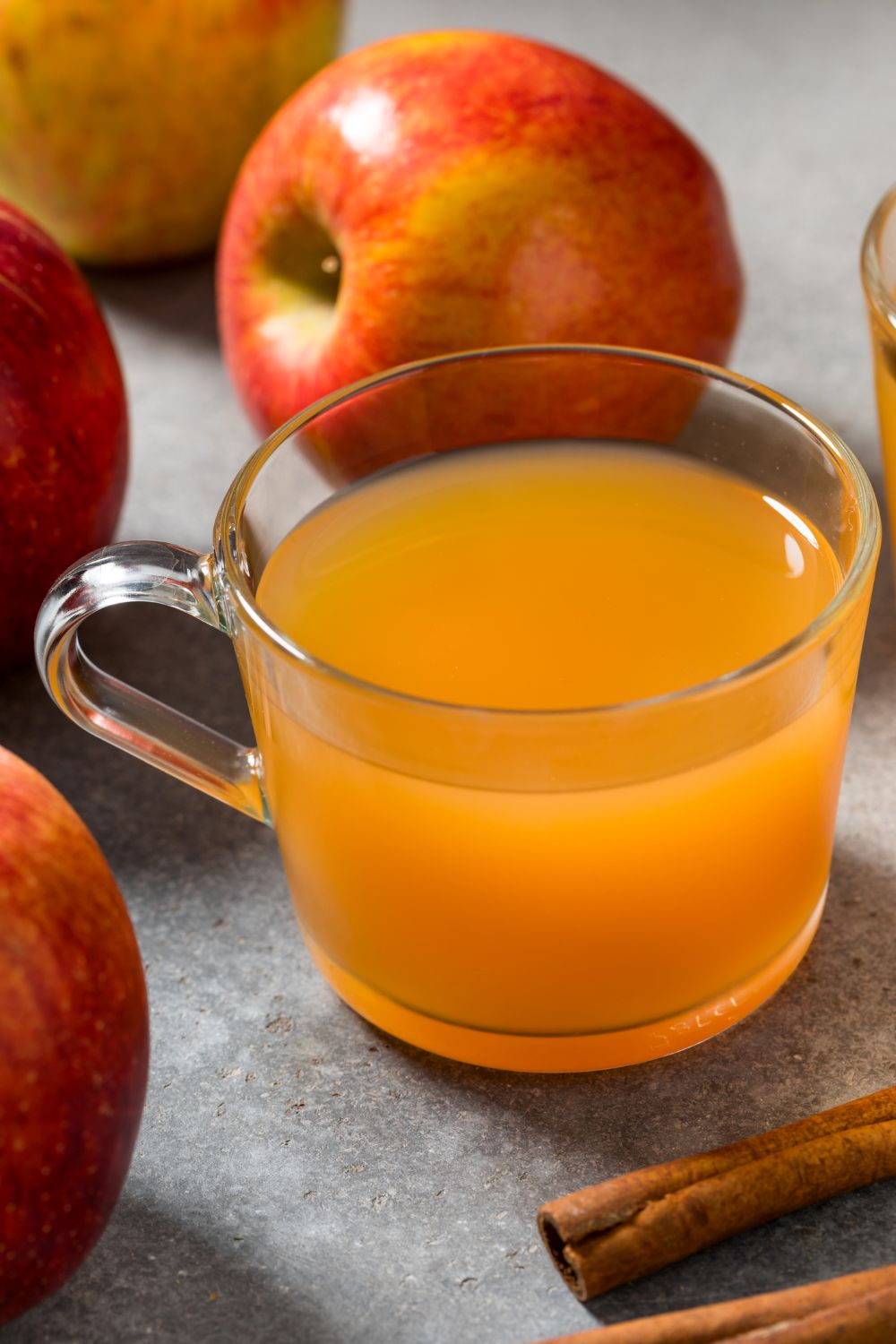This homemade hot mulled apple cider transforms ordinary apple cider into a warmly spiced autumn beverage with just a bit of effort, using whole spices and fresh citrus. This recipe uses an electric juicer for convenience, though you can achieve similar results with a traditional apple press, blender method, or even the stovetop simmering technique. Unlike store-bought versions with artificial flavoring, this stovetop mulled cider recipe fills your home with the genuine aroma of cinnamon, cloves, and star anise while you simmer.
Making homemade mulled cider is a tradition my husband and I started together because it reminded us of cold, snowy winter holidays growing up in Wisconsin. The first time we simmered it on our stove, the whole house filled with that unmistakable warmth of cinnamon, cloves, and sweet apples mingling in the steam. It became our way of recapturing those childhood winters now that we live in Texas.
The Quiet Appeal of Real Homemade Apple Cider
This seasonal tradition, with roots stretching back centuries, is about bringing people together. Each simmering pot carries echoes of old recipes and new conversations, making mulled cider a drink that's both familiar and, every time, a little bit new.
Before we explore the rich history behind it, let's clarify what "apple cider" means in the American sense. It's that beautiful, cloudy, unfiltered juice, alive with tiny bits of fresh apple, delivering the genuine flavor we associate with real cider. Unlike hard cider, this sweet version is non-alcoholic, capturing the pure essence of apples in every sip and reflecting the season itself, evoking crisp air, turning leaves, and a quiet, comforting pause as the year winds down.
Each apple variety brings its own distinctive flavor: Honeycrisp offers a bright, sweet crispness, while Granny Smith adds just the right hint of tartness for balance, making each batch a subtle celebration of the orchard's variety. Even blending different apple types can create a cider uniquely its own, where the notes of each variety harmonize to heighten the flavor and enrich the experience.
The Story of Cider in America
The tradition of adding mulling spices to create the perfect warm cup dates back to old England, where families enjoyed hot, spiced cider during Christmastime. It all started with wassail, a warm punch made with ale or wine and infused with cinnamon, nutmeg, and ginger. "Waes Hail," they would toast, meaning "good health." This cherished ritual crossed the ocean with families wanting to keep cozy memories alive, making the mulled apple cider recipe a staple for holiday parties and fall gatherings.

Homemade Hot Mulled Apple Cider
This homemade mulled apple cider transforms fresh apples into pure autumn comfort. Starting with freshly juiced apples, then combining them with simmered apple pulp and warming spices, this recipe creates a rich, deeply flavored cider that fills your home with the essence of the season.
- Total Time: 1 hour, 25 minutes
- Yield: about 1 gallon 1x
Ingredients
- 4 bags of apples
- Cinnamon bark or sticks (about 6)
- 1 tablespoon nutmeg
- About 6 crushed whole cloves
- 1 orange
- 1 gallon spring water
Instructions
- Juice the Apples
Core and slice apples with an apple slicer, then put all the apple slices through the juicer. 4 bags will make about ½ gallon of apple juice. Save the pulp! - Simmer Down the Pulp
Put all the apple pulp into a large stockpot and add 1 gallon of spring water. On medium-high heat, bring the pulp to a boil and keep it at a rolling boil for at least 5 minutes. - Strain the Pulp
Ladle the boiled pulp into a fine-mesh sieve and press the liquid into a pot or container. - Combine All Ingredients
To a stockpot, add:
½ gallon of the freshly juiced apples
All of the strained liquid from the pulp
About 6 cinnamon sticks
About 6 crushed cloves
1 tablespoon of nutmeg
1 sliced orange
Alternately, place cinnamon sticks and whole cloves into a cheesecloth, tie it up and throw it in the pot. - Simmer
Simmer the cider on low heat for an hour.
Notes
When selecting the type of apples to use for homemade cider, it simply comes down to personal preference. You can choose to use a combination of sweet and tart apples like Gala and Granny Smith. If you prefer the taste of Fuji apples, use all Fujis for your recipe. There are no wrong apples to use for hot cider.
For our hot spiced apple cider, we use 1 bag of Red Delicious, 1 bag of Granny Smith, and 2 bags of Galas.
One more thing to note: the orange can be sliced and simmered in the cider (my preferred method), used as a garnish, or left out entirely. Sully doesn’t care for the orange addition, so he leaves it out. Serve with a shot of brandy!
- Prep Time: 20 minutes
- Cook Time: 1 hour, 5 minutes
- Category: Drinks
- Cuisine: English
Why This Is the Best Mulled Apple Cider Recipe
How to Make Perfect Mulled Apple Cider
Recipe Variations
Frequently Asked Questions
Apple cider is unfiltered pressed apples with natural pulp and sediment, creating a richer body and authentic apple flavor. Apple juice is filtered clear and often from concentrate, resulting in a thinner texture and less complex taste that doesn't mull as successfully.
Absolutely. Prepare the mulled cider up to 2 days ahead and refrigerate in an airtight container. Reheat slowly on the stovetop 30 minutes before guests arrive, then transfer to a slow cooker set on warm for self-service throughout your gathering.
Mulled apple cider maintains optimal flavor and aroma for 3-4 hours when kept warm in a slow cooker on the low or warm setting. Beyond that timeframe, the spices can become bitter, and the apple notes fade.
The spices will have released most of their essential oils during the first batch, so reusing them produces weak, lackluster flavor. Always use fresh whole spices for each new batch to ensure the characteristic warmth and aroma.
For homemade cider, blend sweet varieties like Honeycrisp or Gala with tart apples such as Granny Smith or Jonathan for balanced flavor. The combination creates natural sweetness with enough acidity to prevent the mulled cider from tasting flat.
Wassail traditionally includes ale or wine along with spiced cider, while mulled apple cider is the non-alcoholic spiced version. Both share similar autumn spices, but wassail has deeper historical roots in medieval England and contains fermented ingredients.
Skip any added sweetener and use a tart cider blend with higher acidity. Adding an extra squeeze of fresh lemon juice also cuts the sweetness while brightening the overall flavor profile without making the drink taste sour.
Over-simmering or boiling the cider extracts bitter tannins from the spices and apples. Always use gentle heat and remove whole spices after 30 minutes maximum to prevent bitterness from developing.
What fall memory does the scent of simmering cider bring back for you? Does it take you to a hayride at dusk, or maybe your grandmother's warm kitchen on a chilly afternoon? Share your mulled cider memories in the comments below.
If you make this homemade hot mulled apple cider, please leave a rating and review! Hearing which spice combinations you loved (or tweaked) helps other readers discover their perfect autumn beverage.




0 comments